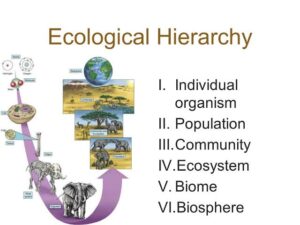Back to: ZOOLOGY 100 Level
It’s always a pleasure having you here! You are doing wonderfully well, and today’s topic will open your eyes even more to the amazing order in nature. We’re learning about something called the ecological hierarchy. It sounds big, but don’t worry — I’ll explain it in a way that’s as simple as telling a friend a story. Let’s go!
Ecological hierarchy: individual, population, community, ecosystem
Ecological Hierarchy
Nature is organised in levels, just like when you arrange your clothes in different shelves — shirts on one side, trousers on another, shoes down below. In ecology, living things are also organised from the simplest to the most complex. This organisation is called the ecological hierarchy. Let’s look at the different levels:

- Individual
An individual is just one single living organism. It can be one cat, one elephant, or one mosquito. The individual is the basic unit of study in ecology because it shows how one organism survives in its environment.
- Example: One chicken in a farmyard scratching for food.
- Population
A population is a group of individuals of the same species living in the same area at the same time. They can interact, mate, and share resources.
- Example: All the chickens in a particular farm form a population.
- Another example: All the mango trees in a village orchard are a population.
- Community
A community is made up of all the different populations living and interacting together in an area. So, it is not just chickens anymore; it includes goats, grasses, butterflies, and even tiny ants.
- Example: In a village farm, chickens, goats, grass, earthworms, and insects all together form a community.
- Ecosystem
An ecosystem is the community plus the non-living things (like water, soil, sunlight, and air) that they interact with. In the ecosystem, living things (plants, animals, and microorganisms) and non-living things work together in a balanced way.
- Example: In a pond, you have fish (population), water (non-living), algae, frogs, stones, and sunlight — all interacting together. That whole system is an ecosystem.
Simple Way to Remember
- Individual → One living thing
- Population → Many of the same living thing
- Community → Many different living things
- Ecosystem → Living things plus non-living things together

Think of it like attending a Nigerian wedding:
- You are an individual guest.
- All the guests wearing the same family cloth (aso ebi) form a population.
- Guests from different families form the community.
- The entire party — guests, decorations, food, music, chairs, and hall — together is the ecosystem!
Summary
- The ecological hierarchy organises living things from individuals up to ecosystems.
- An individual is one organism.
- A population is a group of the same organism.
- A community includes different populations living together.
- An ecosystem is the community plus non-living things interacting in a balanced system.
Evaluation
- What is the basic unit of study in ecology?
- Define a population with an example.
- What makes up a community?
- What extra elements are included when moving from a community to an ecosystem?
- Give one real-life example of an ecosystem.
You are doing so well, and I am very proud of your commitment to learning! Every step you take brings you closer to greatness. Keep shining with Afrilearn — your dreams are valid, and you are unstoppable!
